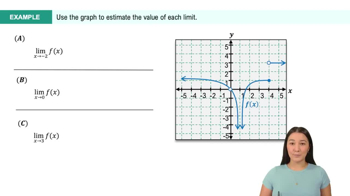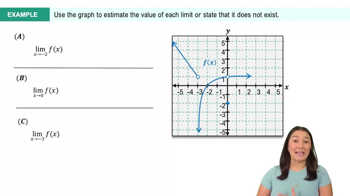Table of contents
- 0. Functions7h 52m
- Introduction to Functions16m
- Piecewise Functions10m
- Properties of Functions9m
- Common Functions1h 8m
- Transformations5m
- Combining Functions27m
- Exponent rules32m
- Exponential Functions28m
- Logarithmic Functions24m
- Properties of Logarithms34m
- Exponential & Logarithmic Equations35m
- Introduction to Trigonometric Functions38m
- Graphs of Trigonometric Functions44m
- Trigonometric Identities47m
- Inverse Trigonometric Functions48m
- 1. Limits and Continuity2h 2m
- 2. Intro to Derivatives1h 33m
- 3. Techniques of Differentiation3h 18m
- 4. Applications of Derivatives2h 38m
- 5. Graphical Applications of Derivatives6h 2m
- 6. Derivatives of Inverse, Exponential, & Logarithmic Functions2h 37m
- 7. Antiderivatives & Indefinite Integrals1h 26m
1. Limits and Continuity
Introduction to Limits
Problem 9b
Textbook Question
Let g(t)=t−3t−9.
Make a conjecture about the value of t→9limt−3t−9.
 Verified step by step guidance
Verified step by step guidance1
First, observe that directly substituting t = 9 into the function g(t) = \frac{t-9}{\sqrt{t}-3} results in an indeterminate form \frac{0}{0}. This suggests that we need to simplify the expression to evaluate the limit.
To simplify, consider multiplying the numerator and the denominator by the conjugate of the denominator, which is \sqrt{t} + 3. This technique helps eliminate the square root in the denominator.
After multiplying, the expression becomes \frac{(t-9)(\sqrt{t}+3)}{(\sqrt{t}-3)(\sqrt{t}+3)}. The denominator simplifies to t - 9, as it is a difference of squares.
Now, the expression simplifies to \frac{(t-9)(\sqrt{t}+3)}{t-9}. Notice that the (t-9) terms in the numerator and denominator can be canceled out, provided t \neq 9.
After canceling, the expression simplifies to \sqrt{t} + 3. Now, substitute t = 9 into this simplified expression to find the limit, which is no longer indeterminate.
Recommended similar problem, with video answer:
 Verified Solution
Verified SolutionThis video solution was recommended by our tutors as helpful for the problem above
Video duration:
3mPlay a video:
Was this helpful?

 6:47m
6:47mWatch next
Master Finding Limits Numerically and Graphically with a bite sized video explanation from Callie
Start learning





